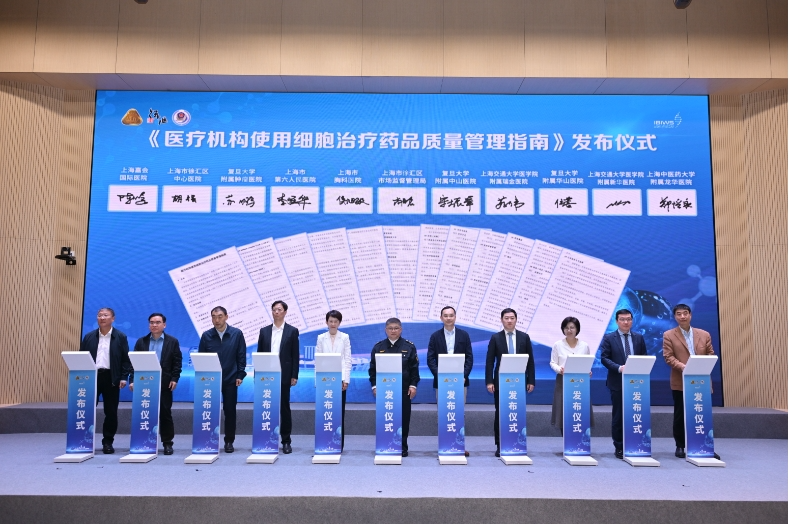
On the morning of November 12, at the Cell and Gene Therapy Drug Innovation and Clinical Development Forum held in Xuhui, Shanghai, under the guidance of the Municipal Food and Drug Administration, the Xuhui District Market Supervision Bureau and 10 medical institutions jointly issued Shanghai City's first "Guidelines for the Quality Management of Cell Therapy Drugs Used in Medical Institutions"(hereinafter referred to as the "Guidelines"), providing standardized guidance for the use of CAR-T innovative drugs and ensuring that people can use safe medicines.

On November 12, the "Guidelines for the Quality Management of Cell Therapy Drugs Used in Medical Institutions" was released in Xuhui, Shanghai. (Photo provided by the interviewed units) As a personalized living cell drug, CAR-T drugs have been successfully used in the clinical treatment of hematological malignancies. At present, three CAR-T drugs in Shanghai have been approved by the State Food and Drug Administration for marketing, accounting for half of the country's total. Nearly 20 medical institutions in Shanghai have passed relevant holder certification and are or will soon apply CAR-T drugs in clinical applications, leading the country. However, compared with the unified procurement and unified management model of conventional drugs by the hospital pharmacy department, most medical institutions have not yet clarified the specific responsible department for CAR-T cell therapeutic drugs.
"How to ensure the quality, safety and effectiveness of medicines costing 1.2 million yuan per injection?" It is the most concerned issue for many patients who use CAR-T drugs clinically. The person in charge of the Pharmacy and Chemical Department of the Xuhui District Market Supervision Bureau told reporters,"The pharmacy departments of some hospitals are not involved in the drug delivery process. Most front-line medical staff from the oncology department or the hematology department directly carry out drug reception, resuscitation and other aspects in the ward. Relevant personnel are also relatively inexperienced in drug quality management and pose certain risks."
In the "Guidelines" released this time, it is proposed for the first time to incorporate the quality management of CAR-T drug use into the unified drug management system of medical institutions, and guide medical institutions to form multidisciplinary diagnosis and treatment teams. The head of the department that uses cell therapy drugs clinically serves as the cell therapy team. The person in charge supervises all aspects of the cell therapy project, and other departments in the hospital clarify their responsibilities and coordinate and participate to effectively ensure the quality, safety and traceability of the drugs used by patients. At the same time, in order to ensure the quality control of CAR-T drug retail-use and delivery, the "Guide" stipulates the quality control requirements and operating requirements of the places involved in the entire process of CAR-T drug use, drug ordering/procurement, delivery and acceptance. The process makes specific provisions, for example, clarifying that "after the drug is delivered to the place designated by the medical institution, according to the acceptance requirements set by the holder, the producer, circulation, and user of the cell therapy drug shall implement multi-party collaborative acceptance. The personnel involved in the acceptance include medical institutions, holders, and third-party companies entrusted by the holders to deliver, drug trading companies, patients or their families, etc."
"Our hospital has referred to the" Guidelines "and formulated a collaborative acceptance system involving the participation of medical institutions, holders and third-party enterprises entrusted by the holders, drug trading enterprises, patients or their families. The pharmaceutical department follows the entire process according to its responsibilities., ensuring that the drug qualification documents are complete and the appearance quality is qualified." said Zhang Jian, director of the Department of Oncology at Fudan University Cancer Hospital.
As a gathering area of medical resources, Xuhui District accounts for a quarter of the city's top-A hospitals and has certain advantages in the clinical use and clinical research of CAR-T drugs. There are currently 5 medical institutions in Xuhui District that have carried out clinical use of CAR-T drugs, accounting for 30% of the city's total. "The release of the Guide is only the first step we have taken. As more innovative drugs and devices are put on the market, we will also keep pace with the times and protect the development and transformation of new drug technologies, the application and promotion of results, so that 'useful' cells and gene therapy products will benefit patients as soon as possible." Gao Wuming, a member of the Party Leadership Group and a second-level researcher of the Market Supervision Administration of Xuhui District, said.